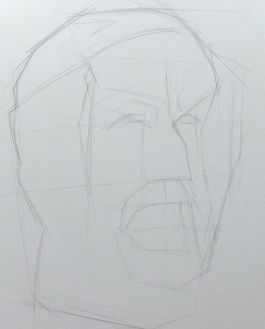
Shadow Shapes
It sounds so trivial, drawing shadow shapes. But the fact is a lot of artists struggle with drawing, or shading in shadow shapes. A different term for this is “blocking in”. Some artists simply just don’t see shadows. They cannot see blocks of tone.
We’re all good at one thing right? I have always had an easy time of seeing shadows shapes. Line however was really tough for me. How about you, do see more with line instead of tone?
The goal is to become balanced with the way we see. Of course you can make something really dimensional with just line. However when you can add line with tone things get a little more interesting.

The Dark Line


Before shading the entire shadow area, artists often establish the core shadow with a "dark line."
This line is a distinct boundary that outlines the transition from light to shadow. It provides a visual cue for the viewer, indicating where the form begins to recede into shadow.
The core shadow is essential for creating a sense of volume and dimension in the artwork. It helps convey the curvature and contours of the form, making it appear more lifelike. Without this transition, the object might seem flat and lack the visual cues needed to understand its three-dimensional nature.


The Dark Shape
The process of filling in shadow shapes with values is a transformative stage in drawing or painting, as it gives solidity and structure to the depicted form. A basic wash of tone has the power to create a sense of three-dimensionality and establish the object's presence within its environment.

Dark Edge
For those facing challenges in discerning the appropriate shadow values, here are a couple of helpful tips.
-
Squint for Simplicity: When working with shadows, always squint at your reference. Squinting simplifies the scene, emphasizing the basic shadow and light shapes by removing intricate details. This technique allows you to focus on the fundamental play of light and shadow.
-
Establish a Three-Value Structure: Approach each drawing with the intention of incorporating a three-value setup. Ensure that your drawings exhibit a clear distinction between dark, middle-tone, and light values. This approach fosters a heightened awareness of shadow shapes and encourages a more structured representation of light and dark areas.
-
Consider Light Source: Before delving into your drawing, ask yourself about the light source. Understanding the direction and origin of the light is fundamental to comprehending the placement and form of shadow shapes. This awareness enables you to make informed decisions about where shadows should fall.
-
Uniformly Shade Shadow Shapes: When shading shadow shapes, employ a solid tone throughout. Avoid leaving patches of white paper visible, as this can disrupt the coherence of lights and darks in your artwork. A consistent and thorough shading of shadow areas contributes to a more polished and cohesive visual result.
-
Seek External Critiques: If you found value in the critiques, consider having your own drawings evaluated. Sometimes, proximity to our own work can hinder our ability to identify challenges or find solutions. External perspectives can provide insights into areas of improvement and guide you past artistic roadblocks.

Remember, the journey of artistic improvement often involves seeking guidance and refining your techniques. Embrace the learning process, and don't hesitate to seek assistance when needed.
Selecting a subject with distinct areas of light and shadow, known for high contrast, is an excellent strategy for honing one's skills in understanding and rendering lighting.







